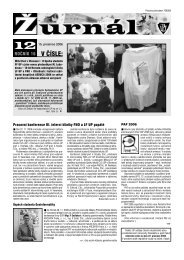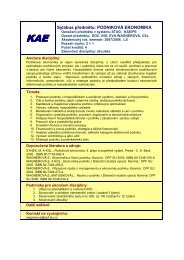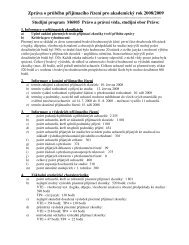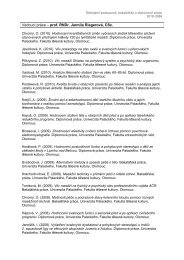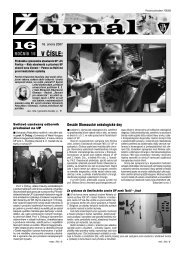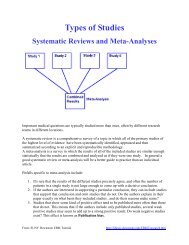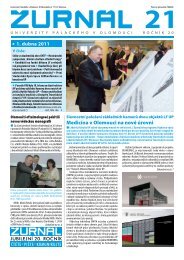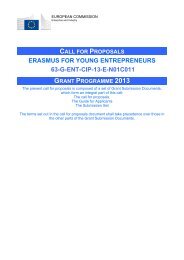8 Acta Univ. Palacki. Olomuc., Gymn. 2004, vol. 34, no. 2According to the concept developed by Maslach, theburnout syndrome is a multi-dimensional phenomenon.Its three dimensions are:Emotional Exhaustion – EE: A subjective senseof exhaustion or depletion of one’s resistance andemotional resources and a loss of the “joie de vivre”.Individuals who manifest this dimension of burnoutshow strong emotional reactions to weak stimuli, areeasily engaged in conflicts, become uncommunicativeand increasingly more emotionally involved in situationsthat require professional interventions.Personal Accomplishment – PA: A subjective assessmentof the value of one’s professional work. Thedimension – the realm of positive feelings – is negativelycorrelated with the other two dimensions; in the courseof the analysis and interpretation of MBI scores, the scaleis reversed. The Negative Sense of Professional AchievementScale (NSPAS) is a tool for diagnosing a decreasedsense of one’s competencies or achievements at work.Depersonalization – DP: It is manifested throughnegative, cool, distanced (or even outright cynical)behaviors towards individuals, with whom the affectedperson maintains work-associated relations. Any problemspertaining to other people are perceived as justlydeserved, for which the said others should suffer consequences(Noworol, 2003, an unpublished manuscript).The phenomenon of burnout progresses with timeand is manifested in various ways in particular individuals.According to Maslach, the presented symptom isan increasing emotional exhaustion, followed by lossof satisfaction over one’s professional achievements. Inconsequence of the situation, the process of depersonalizationbegins – the affected person distances himselffrom specific stress posed by another human being(Noworol, 2000). Burned-out individuals are defi nedas persons manifesting the triad of the factors characteristicof the multi-dimensionally analyzed syndrome(Krawulska-Ptaszyńska, 1992).emotional exhaustion⇒ negative sense of professional achievements⇒ depersonalizationAccording to McConnell, the tri-dimensional burnoutsyndrome develops at three levels (McConnell,1982, in Noworol, 1989).Level 1:Mild, short-term symptoms that appear incidentally;– the symptoms may be relieved via relaxation or workbreaks.Level 2:The symptoms are intensifi ed and occur more regularly;– the typical strategies of symptom alleviation, suchas, for example, weekend rest and recreation, ceaseto be successful;– the recovery and ability of continued self-care requirean additional effort.Level 3:Continuous signals of burnout, physical and mentalproblems appear (depression, manic states);– any efforts directed towards relieving the symptomson one’s own are pointless;– any professional help does not provide an immediateeffect.Based on the theory developed by Maslach, Golembiewskidetermined a contrary direction of the burnoutpathway. In his opinion, depersonalization, also understoodas the effect of stress that leads to a lowered sensitivitythreshold, and in consequence to the developmentof distancing behaviors, is the first factor to appear. Thereaction of other fellow-workers to the increasing coolnessand distance in professional contacts with theaffected person with progressive burnout leads in the latterto a decreased sense of self-esteem and professionalachievements. As a result of intensified symptoms, theemployee starts to react in the emotional sphere, whichleads to emotional burnout (Noworol, 2000).depersonalization⇒ negative sense of professional achievements⇒ emotional exhaustionThe burnout process described by Maslach andGolembiewski may be schematically represented asa system of pathways that have reverse directions. Inview of this fact, these theories have been termed “facingtheories” (Noworol, 2000).The seemingly contrary theories have been combinedinto a comprehensive unity in the four-stage typologicalmodel of burnout that has originated from theeight-stage model developed by Golembiewski (Noworol& Marek, 1994).In the typological model (Fig. 6), the burnoutprocess includes four major stages: T0 (Unaffected byburnout), T1, T2, T3 (Burned-out), with the T1 and T2phases being complex. The progressive burnout processmay proceed along various paths that are specificfor a given individual (a micro-path), or a professionalgroup (a macro-path), which is depicted in Fig. 6. Thefacing theories constitute two separate paths in the fourstagemodel – the theory developed by Maslach describesthe burnout process in the so-called helping professions,while the solution proposed by Golembiewski explains theintensification of the syndrome chiefly in the managerialprofessions (Noworol, 2000).Polish studies on the phenomenon of burnout inteachers chiefly concentrate on analyzing the problemin relation to methods of coping with stress, somepersonality and temperament-associated determinants,
Acta Univ. Palacki. Olomuc., Gymn. 2004, vol. 34, no. 2 9sexual identity, social support, level of education offeredand type of school (public schools, special educationschools), sex, age, education, as well as the time of practicingthe profession (Krawulska-Ptaszyńska, 1992; Sęk,1994, 1996; Golińska & Świętochowski, 1998; Kliś &Kossewska, 1998; Przybyła, 1998; Mandal, 1999;Sekułowicz, 2002; Tucholska, 2003). Świętochowski(2001) investigated the effect of burnout on non-clinicalsomatic disorders among teachers. Tucholska (2003), inher cross-sectional study of general education schoolteachers(N = 256), included a variable of the subjecttaught; the number of investigated physical trainingteachers was N = 16. Using the concept developed byGolembiewski, she also proposed a sequence of increasingburnout symptoms in the studied group.The aim of the present report was to answer thequestion of how the burnout syndrome developed inphysical training teachers and to attempt to define themacro-path of burnout in teachers of this subject.Two hypotheses were formulated:In view of the specific character of their work, thepopulation of female and male physical training teachersmanifests the phenomenon of burnout.The course of the burnout macro-path among physicaltraining teachers is in agreement with the burnoutpath described by Maslach, the latter illustrates theprocess as occurring in social professions.METHODThe study employed the method of diagnostic pollingand was carried out between February and September,2003, among physical training teachers from variousCracow and Wieliczka schools (elementary, junior highand high), students of the Cracow Academy of PhysicalEducation (freshmen attending the post-baccalaureateextramural program, students of extramural courses)and participants of three post-grad courses for physicaltraining teachers organized by Province PostgraduateTraining Center for Teachers in Cracow and Nowy Sącz(N = 256; women N = 144, men N = 112).Among the respondents, the most numerous groupconsisted of physical training teachers employed byelementary schools (38.7%) in large urban centers(province capital – 72.3%, district towns – 19.1%, ruralareas – 8.6%). The mean age of the respondents was36.9 years, the mean duration of employment in schoolamounted to approximately 13 years (TABLE 4), withthe range of age and employment duration of 23–57 and1–40 years, respectively.To diagnose the burnout syndrome, the Maslach BurnoutInventory (MBI Form Ed.) was employed; the scalehad been adapted to Polish conditions by Noworol (1994;an unpublished manuscript). The MBI questionnaireallows for determining the level of burnout as a consequenceof chronic emotional stress in a work setting.The questionnaire consists of 22 statements groupedinto three subscales:• Emotional Exhaustion (EE) – 9 items;• Negative Sense of Professional Achievement (NSPA)– 8 items;• Depersonalization (DP) – 5 items.Using a seven-point scale, each responder determinesthe frequency of experiencing a given state. The scaleranges from 0 – never, to 6 – every day; the intermediatevalues denote the frequency of once/several times peryear, month, and week.The empirical material was analyzed using the varianceanalysis, the non-parametric U Mann-Whitney test(Ferguson & Takane, 1999), as well as the cluster analysis(the k-mean method of Mac Quin) (Noworol, 1987)and employing the SPSS/11 statistical software.RESULTSIn the investigated population of physical trainingteachers, the gender variable basically did not affectthe structure of the burnout phenomenon. Only inthe group of women was emotional exhaustion (EE)slightly more pronounced (p < 0.05) (TABLE 1). Themean values of the other dimensions (NSPA and DP)did not differ significantly.TABLE 1The burnout structure among female and male teachersof physical trainingFemales N = 144 Males N = 112MBI x – SD x – SD pEE 13.56 8.302 11.70 8.560 0.042NSPA 11.53 7.682 10.36 6.865 0.255DP 3.85 3.847 4.42 4.026 0.204EE – emotional exhaustion, NSPA – negative sense of professional achievement,DP – depersonalizationTABLE 2Burnout among physical training teachers – the clusteranalysisBurnout among physical training teachersCluster N % – x Me SD min maxI. 150 58.6 18.67 19.00 8.27 1 45II. 1 0.4 105.00 105.00 – 105 105III. 30 11.7 30.53 28.50 7.14 18 49IV. 6 2.3 44.33 44.50 8.64 30 54V. 69 27.0 44.14 42.00 10.60 29 74Total 256 100 27.86 26.00 15.14 1 105
- Page 1 and 2: ACTAUNIVERSITATIS PALACKIANAE OLOMU
- Page 3 and 4: ACTAUNIVERSITATIS PALACKIANAE OLOMU
- Page 5: Acta Univ. Palacki. Olomuc., Gymn.
- Page 10 and 11: 10 Acta Univ. Palacki. Olomuc., Gym
- Page 12 and 13: 12 Acta Univ. Palacki. Olomuc., Gym
- Page 14: 14 Acta Univ. Palacki. Olomuc., Gym
- Page 17: Acta Univ. Palacki. Olomuc., Gymn.
- Page 20 and 21: 20 Acta Univ. Palacki. Olomuc., Gym
- Page 22: 22 Acta Univ. Palacki. Olomuc., Gym
- Page 26 and 27: 26 Acta Univ. Palacki. Olomuc., Gym
- Page 28 and 29: 28 Acta Univ. Palacki. Olomuc., Gym
- Page 32 and 33: 32 Acta Univ. Palacki. Olomuc., Gym
- Page 34 and 35: 34 Acta Univ. Palacki. Olomuc., Gym
- Page 36 and 37: 36 Acta Univ. Palacki. Olomuc., Gym
- Page 38 and 39: 38 Acta Univ. Palacki. Olomuc., Gym
- Page 40 and 41: 40 Acta Univ. Palacki. Olomuc., Gym
- Page 43 and 44: Acta Univ. Palacki. Olomuc., Gymn.
- Page 45 and 46: Acta Univ. Palacki. Olomuc., Gymn.
- Page 47 and 48: Acta Univ. Palacki. Olomuc., Gymn.
- Page 49 and 50: Acta Univ. Palacki. Olomuc., Gymn.
- Page 51 and 52: Acta Univ. Palacki. Olomuc., Gymn.
- Page 53 and 54: Acta Univ. Palacki. Olomuc., Gymn.
- Page 55 and 56: Acta Univ. Palacki. Olomuc., Gymn.
- Page 57 and 58: Acta Univ. Palacki. Olomuc., Gymn.
- Page 59:
Acta Univ. Palacki. Olomuc., Gymn.
- Page 62 and 63:
62 Acta Univ. Palacki. Olomuc., Gym
- Page 64 and 65:
64 Acta Univ. Palacki. Olomuc., Gym
- Page 66 and 67:
66 Acta Univ. Palacki. Olomuc., Gym
- Page 68 and 69:
68 Acta Univ. Palacki. Olomuc., Gym
- Page 70 and 71:
70 Acta Univ. Palacki. Olomuc., Gym
- Page 72 and 73:
72 Acta Univ. Palacki. Olomuc., Gym
- Page 74 and 75:
74 Acta Univ. Palacki. Olomuc., Gym
- Page 76 and 77:
76 Acta Univ. Palacki. Olomuc., Gym
- Page 78 and 79:
ACTAUNIVERSITATIS PALACKIANAE OLOMU




